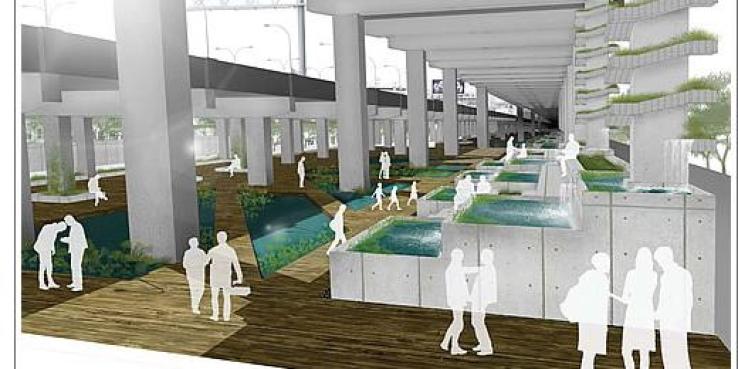Over the last year, there’s been palpable buzz in San Francisco around eco-districts — essentially, sustainability plans that operate at the neighborhood scale. We’ve learned about different eco-district models and how eco-districts are working in Portland, Seattle, Brooklyn and Denver. The San Francisco Planning Department has been especially proactive in this learning process, putting together numerous presentations on district-scale infrastructure and sustainability throughout 2012. The largest of these meetings, held last August at SPUR, kicked off a planning process for an eco-district in the Central Corridor of San Francisco. This 24-square-block area south of Market Street, centered around 4th Street, is currently undergoing a neighborhood planning and rezoning process to better manage and support growth around the new Central Subway.
What’s the buzz about? In areas of transition like the Central Corridor — once an industrial area and increasingly the home of the city’s high-tech sector — neighborhood rezoning creates many opportunities for new development. Some of this will be private development on sites within the corridor, and some will be public investment in transportation assets, water, wastewater, energy and neighborhood parks. The Central Corridor Eco-District was conceived to help the transitioning neighborhood perform well on the city’s environmental goals for greenhouse gas reductions, zero waste, water conservation and efficiency, stormwater management, renewable energy, transportation and more.
In a city where neighborhood edges are somewhat blurry, why focus on sustainability at this scale instead of an “all-of-the-above, everywhere” approach? After all, many of the city’s environmental goals make the most sense when implemented wherever possible and feasible. For example, SF has a rule requiring all residents to compost and recycle; as a result the city is well on its way toward achieving its zero waste goals. Properties in the Central Corridor surely will comply, and perhaps even innovate to exceed our current citywide waste diversion rate of 78 percent. But there is little magic to the boundary around the Central Corridor in accelerating our progress on this goal. Similarly, cooperation between properties is unlikely to boost energy efficiency upgrades, which are typically performed within the building envelope.
But at the neighborhood scale, some things stand out as real possibilities to accelerate sustainability. In these cases, proximity to a specific project or opportunity — and to property owners interested in making it happen — could make all the difference. A neighborhood-scale focus can bring two unique opportunities to the cause of sustainability:
1. Neighborhood-scale aggregation of resource demand, such as energy and water. An eco-district organization in the Central Corridor might be able to enroll numerous properties in a solar group purchase, which secures discounted pricing, or in community-shared solar, possibly using the buildings in the district. An eco-district could also set up an efficient district energy system, which produces steam, heated water and chilled water at a central plant and distributes the energy to multiple connected buildings, so they do not need to have their own boilers or chillers. An eco-district organization could facilitate water reuse between properties, too, such as harvesting rainwater from multiple properties to irrigate a neighborhood park or street landscaping. New buildings that incorporate onsite water treatment or that are plumbed for recycled water (already a requirement in the Central Corridor) might soon be allowed to supply or use another property’s captured and treated wastewater for non-potable uses. In general, community-scale systems can offer lower development costs, reduced capital and operating costs, and higher property values.
2. A coordinated approach to meeting environmental goals, especially where there is a mix of existing land uses and building projects being developed under different time frames. While not all renewable energy or water reuse opportunities require neighborhood-scale participation to succeed, an organization dedicated to furthering sustainability goals within a neighborhood — especially following rezoning — may be able to find opportunities to invest in more sustainable systems. The SF Planning Department is already working on an evaluation of the Central Corridor’s energy use today, and what it might look like with changes from future growth; it is also planning a district energy system in the Transbay Redevelopment Area, another mixed-use, high-density development area that could benefit from a shared, closed-loop system. Eco-district organizations can engage existing property owners to identify a hyperlocal sustainability vision and goals, assess needs and opportunities, and identify the right timing and funding sources to build out the new infrastructure. They can be very proactive about local public engagement and in educating new property owners and managers about sustainability activities the district may require or encourage.
Optimal Energy Use at Different Scales

Different energy systems and infrastructure are most optimal — delivering the greatest benefits for the least cost — at different scales. Heating and cooling networks are two systems that provide the most benefits at the district scale (represented in this preliminary example as "Block" and "Campus.") Image courtesy Arup, SERA and Sherwood.
In the Central Corridor, there are several studies already underway to assess the potential for such sustainable infrastructure as district energy, district water, greening and habitat connectivity, and waste management. Over the next few months at SPUR, Central Corridor stakeholders, including property owners and city agencies, are meeting to establish an ecological vision for the neighborhood, and to figure out how an eco-district organization should be run. There are several models for this, including business management associations, and special tax districts, like community benefits districts, that allow property owners to tax themselves while keeping control of how pooled funds are spent.
Through it all, we should not forget that downtown San Francisco is already the most sustainable job center in the region due to its walkable, compact nature and its rich transit infrastructure. Besides making the Central Corridor more sustainable, we should make sure that the larger neighborhood rezoning process provides enough housing and employment space to meet our future needs. At SPUR we will be following these parallel processes to ensure the best possible outcome for the Central Corridor, the city and indeed the whole region’s sustainability goals.
